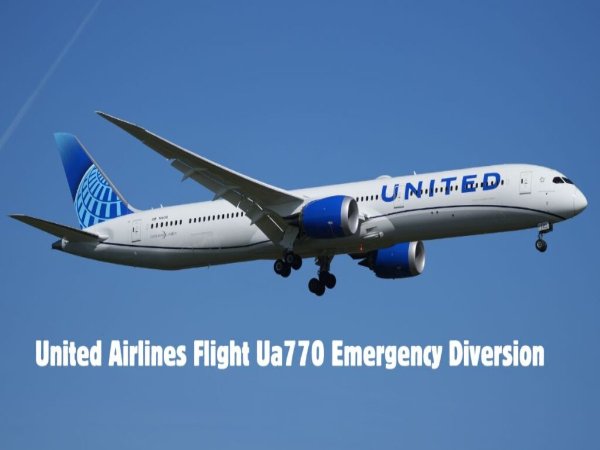United Airlines Flight UA770 Emergency Diversion: Inside the Mid-Flight Crisis That Changed a Routine Journey
How a routine transatlantic flight became an urgent emergency diversion, highlighting aviation safety and crew expertise

United Airlines Flight UA770 emergency diversion occurred when a routine transatlantic flight from Barcelona to Chicago was interrupted mid-air due to a technical issue involving cabin pressurization. Approximately 90 minutes after takeoff, the crew detected the anomaly and declared an emergency, diverting the Boeing 787-9 Dreamliner to London Heathrow Airport. The flight landed safely with no injuries, showcasing the importance of rigorous safety protocols, real-time monitoring systems, and highly trained crew in managing in-flight emergencies effectively.
Introduction
Air travel has become an essential part of modern life, connecting people and places across the globe. Passengers boarding commercial flights generally expect a smooth, uneventful journey. However, aviation emergencies, although rare, remind us of the complexities and risks involved in flying. The recent incident involving United Airlines Flight UA770 emergency diversion serves as a powerful case study in how airlines handle unforeseen mid-flight crises to safeguard passengers and crew.
This article explores the events of Flight UA770’s emergency diversion, the technical challenges faced, crew response, and the broader implications for aviation safety. Understanding these elements offers reassurance about air travel safety and the critical role of aviation professionals in crisis management.
What Happened on United Airlines Flight UA770?
United Airlines Flight UA770, operating a Boeing 787-9 Dreamliner, departed Barcelona El Prat Airport bound for Chicago O’Hare International Airport. Approximately 90 minutes into the flight, cruising over the Atlantic Ocean, the flight crew identified a potential cabin pressurization issue—a serious concern at high altitudes.
The crew declared a general emergency by activating the squawk code 7700, signaling air traffic control that an urgent situation was underway. To ensure passenger safety, the flight was diverted to London Heathrow Airport, a major international hub equipped to handle emergency landings and rapid response.
Despite the sudden emergency, the aircraft touched down safely, and no injuries were reported. Passengers were assisted by airline staff and rerouted to their final destinations.
Understanding the Technical Issue: Cabin Pressurization Anomalies
At high altitudes, aircraft cabins are pressurized to provide a safe and comfortable environment for passengers and crew. The cabin pressure system maintains oxygen levels and air pressure equivalent to those found at lower altitudes, preventing hypoxia (oxygen deprivation).
A pressurization issue can arise from leaks, valve malfunctions, or sensor errors. If the cabin pressure drops unexpectedly, oxygen masks may deploy automatically, and pilots must descend to a safer altitude.
In Flight UA770’s case, early reports suggested a malfunction in the pressurization system. However, the crew managed the situation without oxygen mask deployment, indicating a controlled response that prevented panic or injury.
The Role of the Crew in Managing Emergencies
Flight crews train extensively to handle emergencies, including pressurization failures. Their role is critical in ensuring passenger safety through:
Clear communication: Keeping passengers informed to reduce fear and confusion.
Following protocols: Executing checklists and emergency procedures promptly.
Coordination: Working with air traffic control and ground emergency services.
On Flight UA770, the crew’s calm and professional handling of the situation minimized distress and contributed to the safe diversion.
Why Divert to London Heathrow?
Choosing an emergency diversion airport depends on multiple factors, including proximity, weather conditions, and available emergency services.
London Heathrow Airport is one of the busiest and best-equipped airports in the world, with:
Advanced navigation and landing systems.
Specialized emergency response teams.
Facilities for accommodating passengers affected by delays.
This made Heathrow an ideal choice for Flight UA770’s emergency landing.
What Happens After an Emergency Diversion?
Following an emergency landing, airlines typically:
Conduct thorough inspections of the aircraft.
Provide care and accommodation for passengers.
Investigate the cause of the incident with aviation authorities.
United Airlines grounded the UA770’s aircraft for inspection and cooperated with aviation regulators to determine the technical fault.
Aviation Safety and Technological Advances
The UA770 incident highlights advances in aviation safety, such as:
Real-time aircraft health monitoring systems that alert crews to anomalies.
Sophisticated cockpit instruments that aid decision-making.
Regulatory frameworks that enforce safety standards and continuous crew training.
These systems work together to reduce risk and enhance emergency response.
Passenger Experience During Emergency Diversions
Though emergencies can be stressful, airlines prioritize passenger welfare through:
Regular updates and transparent communication.
Immediate medical and psychological support if needed.
Efficient rebooking and compensation policies.
The calm and orderly response during Flight UA770’s diversion reflects these priorities.
Broader Implications for the Aviation Industry
Every incident like Flight UA770’s emergency diversion offers lessons to improve:
Aircraft maintenance protocols.
Emergency training programs.
Regulatory oversight.
It also reassures travelers about the robust safety nets in place during air travel.
Conclusion
The United Airlines Flight UA770 emergency diversion is a testament to the aviation industry’s commitment to safety and professionalism. While the event disrupted what should have been a routine trip, the swift and competent response by the flight crew, supported by advanced technology and infrastructure, ensured a safe outcome.
This incident underscores the importance of continuous vigilance, training, and technological investment in aviation to protect lives and maintain confidence in air travel worldwide.



